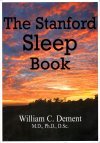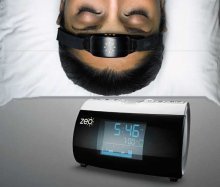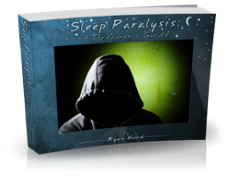
| Connect & Subscribe |
Vital Information About Sleepwalking
A Brochure
An Outreach Project by Chris Jenkins | Return To Outreach Projects 2010
The following is a brochure created for Stanford Sleep and Dreams. If it is difficult to read using the images, you may view the full text here.
Also feel free to download this brochure for distributional or general information purposes. Please refer to our privacy policy for our relevant disclaimers.
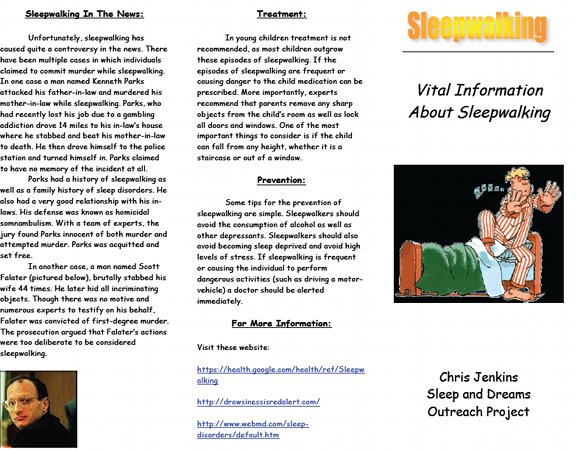
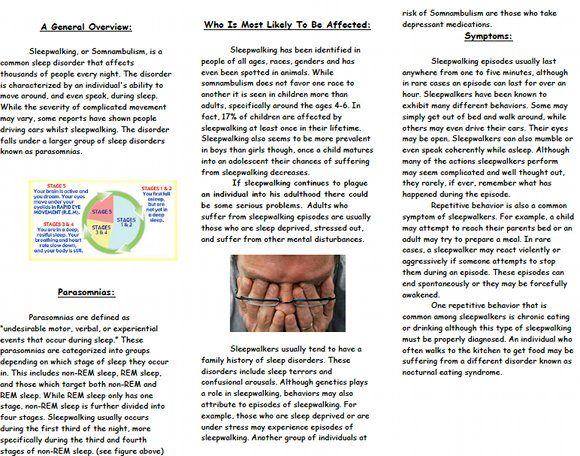
A General Overview
Sleepwalking, or Somnambulism, is a common sleep disorder that affects thousands of people every night. The disorder is characterized by an individual's ability to move around, and even speak, during sleep. While the severity of complicated movement may vary, some reports have shown people driving cars whilst sleepwalking. The disorder falls under a larger group of sleep disorders known as parasomnias.
Parasomnias
Parasomnias are defined as "undesirable motor, verbal, or experiential events that occur during sleep." These parasomnias are categorized into groups depending on which stage of sleep they occur in. This includes non-REM sleep, REM sleep, and those which target both non-REM and REM sleep. While REM sleep only has one stage, non-REM sleep is further divided into four stages. Sleepwalking usually occurs during the first third of the night, more specifically during the third and fourth stages of non-REM sleep. (see figure above)
Who is most likely to be affected
Sleepwalking has been identified in people of all ages, races, genders and has even been spotted in animals. While somnambulism does not favor one race to another it is seen in children more than adults, specifically around the ages 4-6. In fact, 17% of children are affected by sleepwalking at least once in their lifetime. Sleepwalking also seems to be more prevalent in boys than girls though, once a child matures into an adolescent their chances of suffering from sleepwalking decreases.
If sleepwalking continues to plague an individual into his adulthood there could be some serious problems. Adults who suffer from sleepwalking episodes are usually those who are sleep deprived, stressed out, and suffer from other mental disturbances.
Sleepwalkers usually tend to have a family history of sleep disorders. These disorders include sleep terrors and confusional arousals. Although genetics plays a role in sleepwalking, behaviors may also attribute to episodes of sleepwalking. For example, those who are sleep deprived or are under stress may experience episodes of sleepwalking. Another group of individuals at risk of Somnambulism are those who take depressant medications.
Symptoms
Sleepwalking episodes usually last anywhere from one to five minutes, although in rare cases an episode can last for over an hour. Sleepwalkers have been known to exhibit many different behaviors. Some may simply get out of bed and walk around, while others may even drive their cars. Their eyes may be open. Sleepwalkers can also mumble or even speak coherently while asleep. Although many of the actions sleepwalkers perform may seem complicated and well thought out, they rarely, if ever, remember what has happened during the episode.
Repetitive behavior is also a common symptom of sleepwalkers. For example, a child may attempt to reach their parents bed or an adult may try to prepare a meal. In rare cases, a sleepwalker may react violently or aggressively if someone attempts to stop them during an episode. These episodes can end spontaneously or they may be forcefully awakened.
One repetitive behavior that is common among sleepwalkers is chronic eating or drinking although this type of sleepwalking must be properly diagnosed. An individual who often walks to the kitchen to get food may be suffering from a different disorder known as nocturnal eating syndrome.
Sleepwalking in the news
Unfortunately, sleepwalking has caused quite a controversy in the news. There have been multiple cases in which individuals claimed to commit murder while sleepwalking. In one case a man named Kenneth Parks attacked his father-in-law and murdered his mother-in-law while sleepwalking. Parks, who had recently lost his job due to a gambling addiction, drove 14 miles to his in-law's house where he stabbed and beat his mother-in-law to death. He then drove himself to the police station and turned himself in. Parks claimed to have no memory of the incident at all.
Parks had a history of sleepwalking as well as a family history of sleep disorders. He also had a very good relationship with his in-laws. His defense was known as homicidal somnambulism. With a team of experts, the jury found Parks innocent of both murder and attempted murder. Parks was acquitted and set free.
In another case, a man named Scott Falater (pictured below), brutally stabbed his wife 44 times. He later hid all incriminating objects. Though there was no motive and numerous experts to testify on his behalf, Falater was convicted of first-degree murder. The prosecution argued that Falater's actions were too deliberate to be considered sleepwalking.
Treatment
In young children treatment is not recommended, as most children outgrow these episodes of sleepwalking. If the episodes of sleepwalking are frequent or causing danger to the child medication can be prescribed. More importantly, experts recommend that parents remove any sharp objects from the child's room as well as lock all doors and windows. One of the most important things to consider is if the child can fall from any height, whether it is a staircase or out of a window.
Prevention
Some tips for the prevention of sleepwalking are simple. Sleepwalkers should avoid the consumption of alcohol as well as other depressants. Sleepwalkers should also avoid becoming sleep deprived and avoid high levels of stress. If sleepwalking is frequent or causing the individual to perform dangerous activities (such as driving a motor-vehicle) a doctor should be alerted immediately.
For more information
Visit these websites:
About This Site
Welcome! This site is continuously being created by students of Dr. William C. Dement's Sleep And Dreams course at Stanford University.
We made this site as a call to action for people all over the world to live healthier, happier, safer, and more productive lives by learning about their own sleep. We have faith that reading the information provided on this site will motivate you to be smart about your sleep deprivation and strategic about your alertness in order to live life to your fullest, most energetic potential.
In fact, we challenge you to do so! What do you say, are you up for the challenge?
Interviews With Sleep Specialists: Insights Into the Worlds of Sleep Medicine & Sleep Business
America's Most Dangerous Disorder: What Is Sleep Apnea Doing To Your Sleep?
Sleep Debt: How Much More Will You Achieve When You Reduce Yours?
The Stages Of Sleep: The Journey Through The Night
Delayed Sleep Phase: You Want To Sleep But You're Not Tired Yet
Paralyzed at Night: Is Sleep Paralysis Normal?
Sleep In Words: Smart, Strange, and Funny Quotes About Sleep
Sleep Disorders In Children: What's Keeping Your Child From A Full Night's Rest?
Attacks of Pavor Nocturnus (a.k.a. Sleep Terrors, Night Terrors, or Incubus Attacks)
The Stanford Sleep Book
Dr. Dement's pioneering textbook has been the core text for Sleep and Dreams since 1980, but it has just recently been made available to the wider public for the first time.
In it you'll find a more detailed account of the most important things you need to know about sleep, alertness, dreams, and sleep disorders. Studies, statistics, plus plenty of Dr. Dement's classic anecdotes painting the history of sleep medicine.
Preface | Intro | Contents | Get A Copy
More Sleep Resources
The Zeo
A revolution in personal sleep tracking, the Zeo is a wireless headband that transmits your brainwaves in realtime to a dock (pictured here) or your smartphone. The result? You can wake up and see exactly what stages of sleep you were in during the night! Unprecedented personalized sleep knowledge.
Sleep Paralysis: A Dreamer's Guide
Ever woken up paralyzed? A surprising number of us have, believe it or not. But few know the actual causes of this phenomenon, and fewer still how to exert control over it. Dream researcher and sleep paralysis expert Ryan Hurd shares breakthrough insights into how to do just that.
Important Disclaimer
Please Note:
The information found on this page and throughout this site is intended for general information purposes only. While it may prove useful and empowering, it is NOT intended as a substitute for the expertise and judgments of healthcare practitioners.
For more info, see our
Terms of Use.







